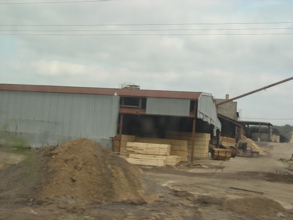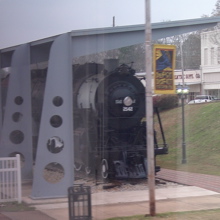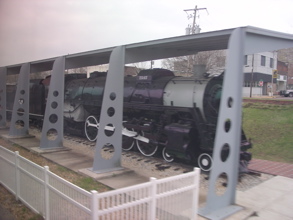Rails
to Riverboats
Amtrak
and River Explorer
Memphis,
TN to New Orleans via the Amtrak City of New Orleans train
returning
to Memphis via the river barge River Explorer.
Trip Report #2 - Memphis to New Orleans.
Upon leaving Memphis Station, I realized
we were in the only sleeper, the last car on the City of New
Orleans. I immediately walked to the back window and took
a photo
of the baggage of the detraining passengers headed back to the Memphis
Station.
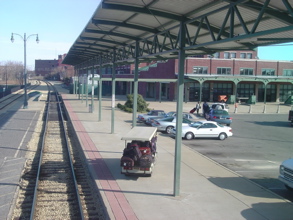
Departing Memphis Station, heading for
New Orleans.
|
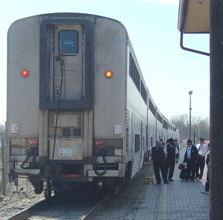
The upper level window where I photographed
the Memphis Station at left.
|
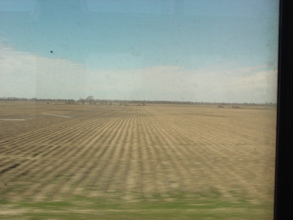
From the Sightseeing Lounge Car, Mississippi
Cotton fields in late winter, after harvest.
|
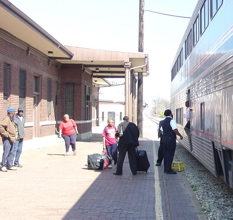
Greenwood, MS.
|
The route of The CIty
of New Orleans. south of Memphis, enters Mississippi, the poorest state
in the Union. This route in particular goes through the poorest
section of the poorest state. We traversed farmland, forests, and
wetlands between Memphis and New Orleans.
Greenwood,
Mississippi,
(From the Route Guide):
This
area has a reputation as a cotton producer dating back to pre-Civil War
times. Located next to the Yazoo River, the city grew steadily
from a busy river landing to one of the largest cotton markets in the
world. Today one-fifth of the world's crop is warehoused and sold
here.
Florewood River Plantation State park, which we passed, but was
not pointed out,
is a living history
park. It is a re-creation of a 1850s Antebellum cotton plantation.
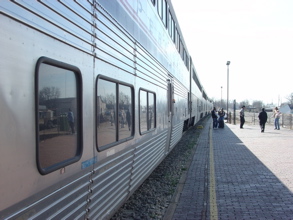
|

Our sleeping car attendant, Carl.
|
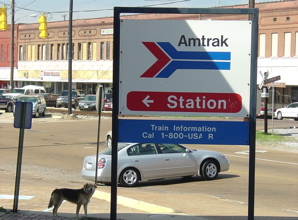
Dog Gone, the train has arrived in
Greenwood, MS!
|
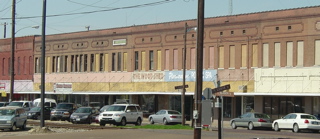
Greenwood, MS, mainstreet with it's classical
Main Street American architecture.
|
The picture above, of the Sightseer
Lounge Car was taken as we were navigating through the train to the
diner. During the trip I met Chuck Strickler, a very congenial
and informative Amtrak Manager from the east coast. We, on the
west coast had been trying to find out about the dining car changes
that had been proposed, so after returning home, I contacted Chuck for
a description. Here is his informed response:
Simplified Dining Service is what you
experienced on the City of New Orleans. Basically Simplified Dining is
an internal change in the way Dining Car operations are organized and
managed on all Long Distance Trains (Excluding Auto Train and the
Empire Builder). All long distance trains will be transitioned to this
service by June 1, 2006. Generally, the dining car crew will be reduced
from a crew of 5 to a crew of 3. The crew will consist of 1 Chef,
1 Lead Service Attendant and 1 Service Attendant. Additional crew
positions will be added upon the anticipated number of meals to be
served per meal period. Passengers will be seated in 15-minute
intervals allowing a more even workflow and create a more relaxing
dining atmosphere. Meal periods will be extended allowing the passenger
more flexibility and convenience when eating. The annualized savings
expected from Simplified Dining Service is in excess of $10 million.
[Thanks, Chuck, for making things clear for TrainWeb.com readers.]
I knew at the time of this trip that Sue and I would be going on the
American Orient Express for the first time (see my report at
trainweb.org/carl/AOE) and we talked about the AOE which Chuck had been
on and was impressed with.
Jackson, Mississippi, from the Route Guide:
You'll notice the tracks rising as you
pull into Jackson Station. Beginning as LeFleur's Bluff, a
trading settlement on the banks of the Pearl River, in 1821, it was
chosen as the state capital and named in honor of Andrew Jackson.
The city grew in prominence, only to be invaded b y General Sherman
three times during the Civil War and burned to the ground. Some
folks say that "Chimneyville," as it came to be called, was where
Sherman practiced for the burning of Atlanta. The city, however,
refused to die and is now the state's largest city and the hub of
trading and transportation.
Attractions in Jackson include the Governor's Mansion (which served as
a hosptial during the Civil War), Dizzy Dean Museum, the Old Capitol
Museum, the Mississippi Petrified Forest (the only such forest in the
Eastern U.S.) Mynelle Gardens and the Oaks, Jackson's oldest Antebellum
cottage (which was occupied by General Sherman during the siege).
About ten miles west, on the campus of Mississippi College, is Provine
Chapel. Here, Confederate soldiers hid in the basement to avoid
capture by Sherman's army.
As the train leaves Jackson, you'll see the Jackson skyline,
distinguished by the gold dome of the state capitol. Built in
1903, this beautiful building is topped by a golden eagle. Its
design closely follows that of the nation's capitol in Washington,
DC. South of Jackson, you'll start to see the pine trees of the
famous Piney Woods. This area provides some of the raw materials
for a huge output of products that make Mississippi a leading forest
industry state, producing pine, oil rosin and turpentine.
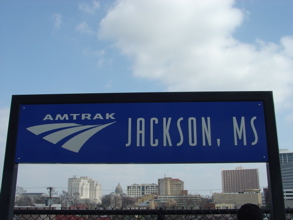
The Amtrak sign at Jackson makes a nice frame for the downtown skyline
on this partly cloudy, warm late-winter day.
McComb, Mississippi, (from
the Route Guide): This town
was named for Colonel Henry Simpson McComb, president of the New Oleans, Jackson and Great Northern
Railroad. He spearheaded reconstruction of the track
following the Civil War. At the station, you can see some of the
historic old cars of the Illinois Central Railroad. The last
steam locomotive, refrigerator car and steam engine that ran on the
line are also here. McComb enjoys the distinction of being the
"Camellia City of America," as no city can boast of a larger
variety...you cross the edge of Osyka and state line into Louisiana.
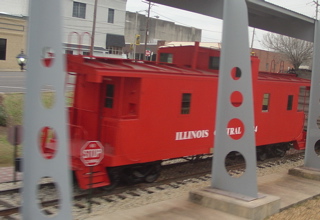 Next Page
Next Page





